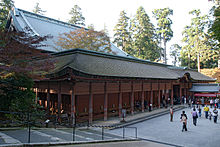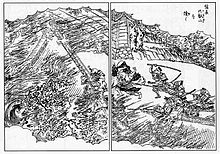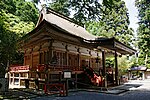Enryaku-ji
| Enryaku-ji | |
|---|---|
 Konpon-chūdō ( | |
| Religion | |
| Affiliation | Tendai |
| Deity | Bhaisajyaguru (Yakushi Nyorai) |
| Location | |
| Location | 4220 Sakamoto Honchō, Ōtsu, Shiga Prefecture |
| Country | Japan |
| Architecture | |
| Founder | Saichō |
| Date established | 788 |
| Completed | 1642 (reconstruction) |
| Website | |
| www | |

Enryaku-ji (
History[edit]
With the support of Emperor Kanmu, the Buddhist monk Saichō ordained a hundred disciples in 807. Maintaining a strict discipline on Mt. Hiei, his monks lived in seclusion for twelve years of study and meditation. After this period, the best students were retained in positions in the monastery and others graduated into positions in the government. At the peak of its power, Enryaku-ji was a huge complex of as many as 3,000 sub-temples and a powerful army of warrior monks (
As part of a program to remove all potential rivals and unite the country, warlord Oda Nobunaga ended this Buddhist militancy in 1571 by attacking Enryaku-ji, leveling the buildings and slaughtering monks.[2] Enryaku-ji's current structures date from the late 16th century through the first half of the 17th century, when the temple was reconstructed following a change of government. Only one minor building survived, the Ruri-dō (るり
Today, most of Enryaku-ji's buildings are clustered in three areas: Tō-dō (
Collusion with organized crime[edit]
On April 4, 2006, Enryaku-ji performed a ceremony for former leaders of Yamaguchi-gumi, by far the largest yakuza organization in Japan.[4]
Because such temple ceremonies have been used for Yamaguchi-gumi fund-raising and demonstrations of power, the Shiga Prefectural Police requested that Enryaku-ji cease performance of the ceremony. Rejecting the request, Enryaku-ji received crime-related money for the ceremony and allowed nearly 100 upper-level Yamaguchi-gumi leaders to attend.
After reports in the Asahi Shimbun and Yomiuri Shimbun newspapers, Enryaku-ji faced a nationwide scandal. The temple was also criticized by the Japan Buddhist Temple Association (representing 75,000 Buddhist temples), which led a movement against the yakuza. [clarification needed] Finally on May 18, all representative directors of Enryaku-ji resigned, apologizing on their website and in e-mails which were sent to 3,000 branch temples.[5]
Gallery[edit]
-
Great Lecture Hall (
大 講堂 , Daikō-dō) -
Hall of Initiation (灌頂
堂 , Kanjō-dō) -
Monju-rō gate (
文殊 楼 , Monju-rō) -
Bell Tower (
鐘楼 , Shōrō) -
East Pagoda (
東 塔 , Tō-tō) -
Amida Hall (
阿弥陀堂 , Amida-dō) -
Ordination Hall (
戒壇 院 , Kaidan-in) -
Yokawa Main Hall (
横川 中堂 , Yokawa-chūdō)
See also[edit]
- Glossary of Japanese Buddhism (for an explanation of terms concerning Japanese Buddhism, Japanese Buddhist art, and Japanese Buddhist temple architecture)
- Guoqing Temple
- Historic Monuments of Ancient Kyoto (Kyoto, Uji and Otsu Cities)
- List of Buddhist temples in Kyoto
- List of National Treasures of Japan (ancient documents)
- List of National Treasures of Japan (crafts-others)
- List of National Treasures of Japan (temples)
- List of National Treasures of Japan (writings)
- Tourism in Japan
Notes[edit]
- ^ Ponsonby-Fane, Richard. (1956). Kyoto: The Old Capital of Japan, 794-1869, p. 111.
- ^ Sansom, George (1961). A History of Japan 1334-1615. Stanford: Stanford University Press. p. 284. ISBN 0804705259.
- ^ "
瑠璃 堂 ". www.kagemarukun.fromc.jp. - ^ Enryakuji temple leaders resign over yakuza service Archived 2012-04-24 at the Wayback Machine
- ^
天台宗 . "天台 の主張 記事 (7)". tendai.or.jp.
References[edit]
- Ponsonby-Fane, Richard Arthur Brabazon. (1956). Kyoto: The Old Capital of Japan, 794–1869. Kyoto: The Ponsonby Memorial Society. [ISBN missing]
External links[edit]
- 8th-century establishments in Japan
- Nara period
- Buddhist temples in Shiga Prefecture
- World Heritage Sites in Japan
- Buildings and structures in Ōtsu
- Tendai
- Tendai temples
- National Treasures of Japan
- Important Cultural Properties of Japan
- Historic Sites of Japan
- Religious buildings and structures completed in 788
- Temples of Bhaiṣajyaguru










